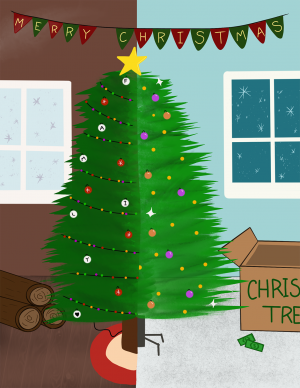Real Christmas trees are the better, more sustainable option
December 23, 2021
For many, the end of Thanksgiving marks the official start of the Christmas season. Lights are hung from houses, holiday decorations start to appear practically everywhere, and many families set out to find that perfect Christmas tree for the holiday season.
However, there is still debate as to what type of tree is better: real or fake.
There is, of course, a very easy answer to this argument. Real trees are vastly superior to fake trees, for several reasons.
Firstly, going to pick out a real tree is an experience the whole family can enjoy. I often look back on these memories and look forward to making new ones in coming years; going out in the afternoon, picking out a unique tree (with hot cocoa, of course), and bringing it home to decorate. The alternative to this is going to your local department store and choosing one of the many identical fake trees sitting in boxes on a shelf. That is certainly not the same experience.
Additionally, real Christmas trees are better for the environment. For every real tree harvested, one to three seedlings are planted the following spring. According to the University of Vermont’s Department of Plant and Soil Science, one acre of Christmas trees provides enough oxygen for 18 people every day. Real trees also absorb carbon dioxide while they grow, which helps to reduce the impacts of climate change. On the other hand, 85% of artificial trees are made in China, according to the National Christmas Tree Association. Transporting these trees overseas consumes oil and fuel and releases carbon emissions, further contributing to the issue of climate change.
And yes, real trees are a more expensive option. However, these costs outweigh the potential hefty, long-term environmental burden that fake trees can bring. For example, fake trees cannot be recycled. Artificial trees are made with harmful chemicals including lead, metal and polyvinyl chloride (PVC), a non-biodegradable plastic, whose pollution is a leading cause of cancer. After disposing of an artificial tree, it will lay in landfills for centuries.
Conversely, there are endless options of ways to dispose of real trees. They can be recycled as mulch, compost or wildlife shelters. The Rockefeller Center’s Christmas tree is even used to build houses, according to the Rockefeller Center.
Some may also claim that using real trees causes deforestation. However, this view is incorrect. The fact is, real trees are often farmed on marginal land that can’t be used for other purposes.
There are many other benefits to getting a real tree for the holiday season, but for sake of time, I will leave you with this: if you celebrate Christmas (or just want a festive, wonderful piney smelling tree in your home) and want to remain guilt-free for the test of time, buy a real tree.









